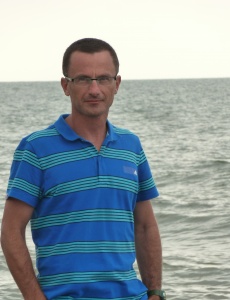Following a B.Sc in Biology and a teacher’s certificate in science education, I continued to a M.Sc. on photophysiology of corals in the department for plant sciences in Tel Aviv University. Following my graduation I spent nearly a year working in the lab of Prof. Roberto Iglesias-Preito in Puerto Morelos in Mexico on coral bleaching. I returned to Israel for my Ph.D. work during which I developed methods for physiological monitoring of coral stress. I continued to do a post doc in Germany where I worked on thermal stress of Zostera marina, a temperate seagrass species. Seagrass are a group of flowering plants (angiosperms) that returned to the marine environment some 60-70 million years ago. These plants have important ecological services and are considered as key stone species in shallow coastal environments. I returned to Israel in 2011 to the Arava where I head the central Arava branch of the Dead Sea Arava Science Center (ADSSC). Although we are situated in the middle of the desert I continue to work on the effects of climate change on seagrasses using a dedicated seagrass mesocosm facility. In this facility Following a B.Sc in Biology and a teacher’s certificate in science education, I continued to a M.Sc. on photophysiology of corals in the department for plant sciences in Tel Aviv University. Following my graduation I spent nearly a year working in the lab of Prof. Roberto Iglesias-Preito in Puerto Morelos in Mexico on coral bleaching. I returned to Israel for my Ph.D. work during which I developed methods for physiological monitoring of coral stress. I continued to do a post doc in Germany where I worked on thermal stress of Zostera marina, a temperate seagrass species. Seagrass are a group of flowering plants (angiosperms) that returned to the marine environment some 60-70 million years ago. These plants have important ecological services and are considered as key stone species in shallow coastal environments. I returned to Israel in 2011 to the Arava where I head the central Arava branch of the Dead Sea Arava Science Center (ADSSC). Although we are situated in the middle of the desert I continue to work on the effects of climate change on seagrasses using a dedicated seagrass mesocosm facility. In this facility we can manipulate water temperatures and CO2 levels which allow us to perform multiple stress experiments related to climate change. Realizing that little is known about seagrass communities in the Gulf of Eilat in the Red Sea, we have recently initiated efforts directed at creating a GIS layer of seagrasses in the northern Gulf of Eilat and following seasonal changes in their depth and geographical distributions. We are looking at changes in biomass, pigment composition and the organisms associated with the meadows at two different sites. We were also part of a first timearticle in Hebrew that explained about seagrasses. In addition to my work in the marine environment, I also lead several studies involving Acacia trees, something much closer geographically to the central Arava location. Like seagrasses that are considered key stone species in the shallow coastal areas, Acacia trees are considered key stone species in arid regions where they improve soil conditions for other plants and provide shelter and food for many desert animals. Indeed it is due to these services that loss of acacia trees entails not only loss of the biota associated with acacia trees themselves but also enhances soil erosion. Realizing the importance of acacia trees to the region, I have recently initiated and organized two acacia international conferences (Oct 2011, Oct 2015) called: Acacia in the Arava – past, present and future. 2011 Conference, 2013 Conference Currently we are studying the population genetics of Acacia tortillis from both sides of the arava (Israel and Jordan), work based on de novo microsatellites that we have recently developed (Winters et al. 2013). Understanding the genetic structure of acacia populations in the region could contribute to a more effective management of acacia trees in the Negev and the Arava. We are involved in monitoring the physiology (using PAM fluoromtery, dendrometers, NIR photography – amongst other techniques) of acacia trees in the region and in experiments looking at the ecophysiological responses of different acacia species and populations to water stress. Additional efforts are underway to try and estimate the biomass and age of acacia trees in the area. Current research: Understanding the genetic population structure of Acacia tortillis (work by Yael Rodger for a M.Sc. thesis, together with Dr. Shrili Bar-David). Acacia trees along the Arava : ecophysiological responses of different species and populations to water stress (work by Tali Rodkov for a M.Sc. thesis, together with Dr. Shimon Rachmilevitch). Studying the effects of climate change on the physiology and gene expression in Halophila stipulacea, a tropical seagrass species common to the northern red sea. Developing a GIS-based tool to protect seagrasses in the Gulf of Aqaba – mapping their distribution, ecosystem services and potential threats (together with Dr. Gil Rilov and Sigal Abramovich).


